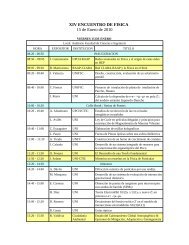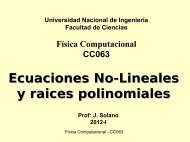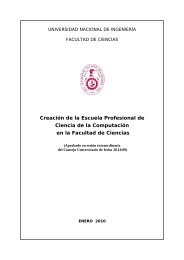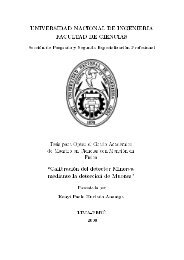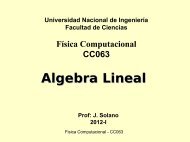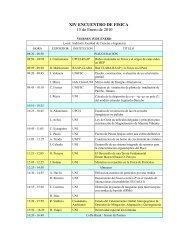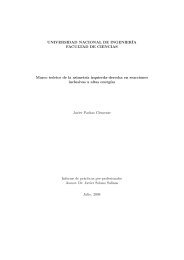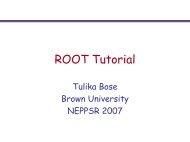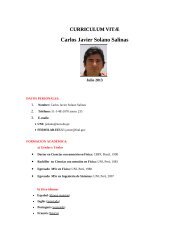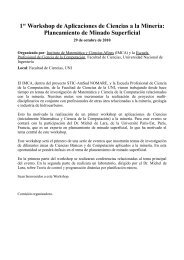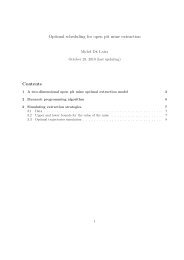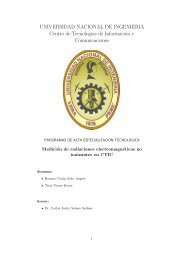Advances and Challenges in the Development and ... - Earthdoc
Advances and Challenges in the Development and ... - Earthdoc
Advances and Challenges in the Development and ... - Earthdoc
You also want an ePaper? Increase the reach of your titles
YUMPU automatically turns print PDFs into web optimized ePapers that Google loves.
IndexTable of contents<strong>Advances</strong> <strong>and</strong> <strong>Challenges</strong> <strong>in</strong> <strong>the</strong> <strong>Development</strong><strong>and</strong> Deployment of Gravity GradiometerSystemsD. DifrancescoLockheed Mart<strong>in</strong>SummaryThe past few years have witnessed significant advances <strong>and</strong> unparalleled <strong>in</strong>terest <strong>in</strong> gravitygradiometer <strong>in</strong>strument technology as well as new deployment scenarios for various applications.Gravity gradiometry is now rout<strong>in</strong>ely considered as a viable component for resource explorationactivities as well as be<strong>in</strong>g deployed for global <strong>in</strong>formation ga<strong>the</strong>r<strong>in</strong>g. S<strong>in</strong>ce <strong>the</strong> <strong>in</strong>troduction of <strong>the</strong>torsion balance <strong>in</strong> <strong>the</strong> 1890’s, it has been recognized that gravity gradient <strong>in</strong>formation is valuable – yetdifficult <strong>and</strong> time-consum<strong>in</strong>g to obta<strong>in</strong>. This paper will summarize advances <strong>in</strong> gradient sensordevelopment, <strong>and</strong> will also look at deployment scenarios <strong>and</strong> gradiometer systems that have beensuccessfully fielded. F<strong>in</strong>ally, we will briefly address <strong>the</strong> most significant challenges associated withimproved gravity gradiometer operational capability <strong>in</strong>clud<strong>in</strong>g <strong>in</strong>strument <strong>and</strong> system <strong>in</strong>tr<strong>in</strong>sic noise,vehicle dynamic noise, terra<strong>in</strong> noise, geologic noise <strong>and</strong> o<strong>the</strong>r noise sources.Gravity Gradient SensorsA boon <strong>in</strong> <strong>the</strong> development of new technologies for measur<strong>in</strong>g gravity gradients has occurred over <strong>the</strong>past few years – spurred <strong>in</strong> part by ris<strong>in</strong>g oil, gas <strong>and</strong> commodity prices as well as a renewedcommitment to basic research. A brief overview of <strong>the</strong>se technologies is provided below:Lockheed Mart<strong>in</strong> Rotat<strong>in</strong>g Accelerometer Gravity GradiometerThe Lockheed Mart<strong>in</strong> gravity gradiometer, which <strong>in</strong>corporates high-precision, room-temperatureaccelerometers, has been operationally deployed for more than 25 years (Metzger, 1982; Hofmeyer,1994). Recent improvements to this <strong>in</strong>strument concept <strong>in</strong>clude <strong>the</strong> digitization of critical signals toprovide for lower noise <strong>and</strong> higher reliability. An additional benefit of this digital design is <strong>the</strong>reduction <strong>in</strong> size <strong>and</strong> weight for <strong>the</strong> <strong>in</strong>stalled system, mak<strong>in</strong>g helicopter surveys possible (Lee, 2006).Gradiometers developed by Lockheed Mart<strong>in</strong> have been deployed <strong>in</strong> commercial systems used byBHP Billiton (FALCON TM ; a partial tensor system with 8 accelerometers); Bell Geospace Inc. (FullTensor Gradiometer – FTG) <strong>and</strong> by ARKeX Ltd. (also us<strong>in</strong>g an FTG system). Figures 1 <strong>and</strong> 2 depictLockheed Mart<strong>in</strong> gravity gradiometers <strong>and</strong> systems.Gravitec Ribbon SensorGravitec Instruments Ltd., a UK company with research operations based <strong>in</strong> Perth, Australia, hasdeveloped a novel concept for measur<strong>in</strong>g gravity gradients. The Gravitec gravity gradiometer sensor iscomprised of a s<strong>in</strong>gle sens<strong>in</strong>g element (a ribbon) that responds to gravity gradient forces (see Figure3). External electronics provide control, measurement <strong>and</strong> modulation functions (Veryask<strong>in</strong>, 2000).The sensor is versatile <strong>in</strong> that <strong>the</strong> sens<strong>in</strong>g element can be configured for airborne, ground, static, orborehole deployment. Specifications for <strong>the</strong> sensor are detailed below:• Dimensions: 400 x 30 x 30 mm• Weight: 500 gms. B<strong>and</strong>width: DC - 1 Hz• Target Sensitivity: 5 E/√Hz flat responseEGM 2007 International WorkshopInnovation <strong>in</strong> EM, Grav <strong>and</strong> Mag Methods:a new Perspective for ExplorationCapri, Italy, April 15 – 18, 2007
Gedex High-Def<strong>in</strong>ition Airborne Gravity Gradiometer (HD-AGG TM )Gedex is <strong>in</strong>tegrat<strong>in</strong>g a high-performance gravity gradiometer with an active six-degree-of-freedomisolation system to m<strong>in</strong>imize vehicle dynamic <strong>in</strong>puts result<strong>in</strong>g <strong>in</strong> a robust system for exploration. Thegradiometer design also uses superconduct<strong>in</strong>g components to achieve low <strong>in</strong>strument quiescent noise.Laboratory tests <strong>in</strong>dicate that noise levels of 0.3 Eotvos at 3 Hz have been achieved (Ma<strong>in</strong>, 2006).Figure 7 shows a schematic of <strong>the</strong> gradiometer (without <strong>the</strong> stabilization system).Figure 7. Layout of <strong>the</strong> Gedex HD-AGG TM .University of Western Australia (UWA) Gravity GradiometerThe UWA Gravity Gradiometer uses an orthogonal quadrupole responder (OQR) design based onpairs of micro-flexure supported balance beams (Tryggvason, 2003). Performance from thisgradiometer is anticipated to be better than 1 E/√Hz. Figures 8 <strong>and</strong> 9 show <strong>the</strong> gradiometer <strong>and</strong> systemconcept.Figure 8. UWA Gradiometer.Figure 9. UWA system concept.EGM 2007 International WorkshopInnovation <strong>in</strong> EM, Grav <strong>and</strong> Mag Methods:a new Perspective for ExplorationCapri, Italy, April 15 – 18, 2007
Gradiometer System DeploymentsGravity gradient measurements have been conducted us<strong>in</strong>g a wide variety of survey scenarios, fromvery simple static collection to <strong>the</strong> use of satellites. Figure 10 depicts a collage of survey mechanismsused to date <strong>in</strong>clud<strong>in</strong>g:• US Navy Trident Submar<strong>in</strong>e Gravity Sensors System (GSS)• Lockheed Mart<strong>in</strong> L<strong>and</strong> Gradiometer System (LGS) – for static measurements• Cessna Gr<strong>and</strong> Caravan (Model 208B) aircraft used by <strong>the</strong> BHP Billiton FALCON TM system,<strong>the</strong> Bell Geospace Full Tensor Gradiometer (Air-FTG ® ) system, <strong>and</strong> <strong>the</strong> ARKeX FTGeX.• Surface ships (e.g. Seacor Surf) used by Bell Geospace for mar<strong>in</strong>e FTG surveys <strong>in</strong> <strong>the</strong> Gulf ofMexico <strong>and</strong> North <strong>and</strong> Barents Seas.• Eurocopter AS350-B3 used by BHP Billiton for FALCON TM surveys.• Zeppel<strong>in</strong> airship used by Bell Geospace <strong>and</strong> DeBeers for FTG surveys <strong>in</strong> Africa.• CHAMP, GRACE <strong>and</strong> GOCE satellite systems to measure <strong>the</strong> earth’s gravity fieldEach of <strong>the</strong> examples identified has a common element of be<strong>in</strong>g viable for measurements <strong>in</strong> ‘realworld’ applications. This is <strong>the</strong> rsult of significant effort focused on <strong>the</strong> development of stabilizedplatform systems to isolate <strong>the</strong> gradiometers from vehicle dynamics, as well as <strong>in</strong>tricate systemeng<strong>in</strong>eer<strong>in</strong>g activity to <strong>in</strong>tegrate <strong>the</strong> gradiometer with <strong>the</strong> host vehicle. In some cases (such as <strong>the</strong>Zeppel<strong>in</strong> airship <strong>and</strong> satellite systems) <strong>the</strong> focus on reduc<strong>in</strong>g high dynamic <strong>in</strong>puts has been extensive.Figure 10. Gravity gradiometer deployment regimes.<strong>Challenges</strong> for Today – <strong>and</strong> <strong>the</strong> FutureGravity gradiometers don’t discrim<strong>in</strong>ate – <strong>the</strong>y ‘see’ everyth<strong>in</strong>g <strong>and</strong> ‘measure’ everyth<strong>in</strong>g. This facthas both positive <strong>and</strong> negative ramifications. While <strong>the</strong> <strong>in</strong>tr<strong>in</strong>sic noise of gradient sensors steadilyimproves, <strong>the</strong> sensitivity to o<strong>the</strong>r noise factors also <strong>in</strong>creases. For example, as <strong>the</strong> resolution of agradient measurement improves by a factor of ten (say from 1 E to 0.1E), <strong>the</strong> <strong>in</strong>fluence of disturb<strong>in</strong>gsources (e.g. terra<strong>in</strong> <strong>and</strong> subsurface geology) also <strong>in</strong>creases by <strong>the</strong> same amount. Liken it to nowsee<strong>in</strong>g <strong>the</strong> trees <strong>in</strong>stead of <strong>the</strong> forest – yet try<strong>in</strong>g to identify <strong>in</strong>dividual timbers <strong>in</strong> <strong>the</strong> group. Many of<strong>the</strong> gravity gradient sensors under development promise lower <strong>in</strong>tr<strong>in</strong>sic noise. Performance claims ofbetter than 1E/√Hz for <strong>the</strong> ARKeX EGG, Stanford AI, Gedex HD-AGG TM <strong>and</strong> UWA OQR sensorspo<strong>in</strong>t to <strong>the</strong> need for better measurement of terra<strong>in</strong> as well as a way of deal<strong>in</strong>g with <strong>the</strong> subsurfacevariations that will now be observable. Figure 11 illustrates <strong>the</strong> concept of “stripp<strong>in</strong>g away” layers ofEGM 2007 International WorkshopInnovation <strong>in</strong> EM, Grav <strong>and</strong> Mag Methods:a new Perspective for ExplorationCapri, Italy, April 15 – 18, 2007
noise comb<strong>in</strong>ed with signal measured by <strong>the</strong> gradiometer – with <strong>the</strong> top layer <strong>in</strong>dicat<strong>in</strong>g <strong>the</strong> totalmeasured gradient, <strong>and</strong> subsequent lower layers <strong>in</strong>dicative of <strong>the</strong> <strong>in</strong>strument/system, terra<strong>in</strong>,subsurface <strong>and</strong> o<strong>the</strong>r noise sources. Ultimately, <strong>the</strong> signal of <strong>in</strong>terest lies beneath all of <strong>the</strong> disruptivenoise sources – <strong>and</strong> <strong>the</strong> challenge <strong>in</strong> process<strong>in</strong>g is to get past <strong>the</strong> noise to <strong>the</strong> geology that is <strong>the</strong> sourceof <strong>the</strong> signal.Figure 11. Multiple signal sources.ConclusionsSignificant advancements <strong>in</strong> gravity gradiometer <strong>in</strong>strumentation <strong>and</strong> deployment have been realized<strong>in</strong> recent years <strong>and</strong> <strong>the</strong> gradiometer is fast becom<strong>in</strong>g a widely accepted tool for <strong>the</strong> geophysicist. Thegravity gradiometer is open<strong>in</strong>g new doors of opportunity <strong>in</strong> <strong>the</strong> resource exploration, hydrocarbonproduction monitor<strong>in</strong>g, <strong>and</strong> emerg<strong>in</strong>g geophysical markets. The challenges for today – <strong>and</strong> <strong>the</strong> future –will be to cont<strong>in</strong>ue to get <strong>the</strong> most signal <strong>in</strong>formation from such surveys through improvements <strong>in</strong> both<strong>in</strong>strumentation <strong>and</strong> process<strong>in</strong>g.ReferencesHofmeyer, G.M. <strong>and</strong> Affleck, C.A. [1994] “Rotat<strong>in</strong>g Accelerometer Gradiometer”, US Patent5,357,802.Lee, J.B. et al [2006] “First test survey results from <strong>the</strong> Falcon TM helicopter-borne airborne gravitygradiometer system”, ASEG abstracts.Lumley, J. M. et al [2001] “A superconduct<strong>in</strong>g gravity gradiometer tool for exploration.” Gradiometryworkshop SEG 2001.Ma<strong>in</strong>, B. [2006] “Noise effects on <strong>the</strong> resolution of <strong>the</strong> GEDEX AGG”, ASEG abstracts.Metzger, E.H. [1982] “<strong>Development</strong> experience of gravity gradiometer system”, IEEE PLANS 82,323-332.Tryggvason, B. V. [2003] “High resolution airborne gravity gradiometer based on an orthogonal massquadrupole”, EGS-AGU-EUG Jo<strong>in</strong>t Assembly (abstract)Veryask<strong>in</strong>, A [2000] “A novel comb<strong>in</strong>ed gravity & magnetic gradiometer system for mobileapplications”, SEG extended abstracts.EGM 2007 International WorkshopInnovation <strong>in</strong> EM, Grav <strong>and</strong> Mag Methods:a new Perspective for ExplorationCapri, Italy, April 15 – 18, 2007



